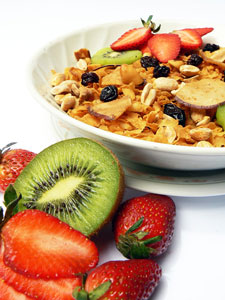For the average American on a busy schedule, eating several, small meals throughout the day can seem impossible. In fact, it’s a downright miracle if three, square meals on any given day actually happen.
As a result of this work-focused lifestyle that often strays from any diet concern, there seems to be a trend in skipping breakfast, eating out for lunch, and overdoing at night to compensate extreme hunger in the evening.
But we all know this isn’t the best approach to health; or at least we should know. The benefits of eating several small meals throughout the day have been touted by many health professionals, and include optimized metabolism function, weight loss, and getting to eat more often.
Stephanie Mansour – CEO of Step It Up with Steph – is a trainer and coach for a weight loss reality TV show called “Put Your Money Where Your Mouth Is.” During the last season, Mansour helped one of her clients lose 83 pounds in just 12 weeks using the small-meal diet approach, focusing on five small meals throughout the day.
Mansour trains all of her clients this way, saying it regulates and speeds up the metabolism, spurs fat burn, and improves digestion.
But it’s not just personal trainers ascribing to this method of eating. Jill Nussinow, a Registered Dietitian, cooking teacher, and self-proclaimed ‘Veggie Queen,’ does, too. Nussinow is a big proponent of eating several small meals throughout the day, because it prevents dramatic blood sugar highs and lows. When we regulate our blood sugar, she says, we’re far less likely to overeat at the next meal.
“I eat this way myself and it works well,” says Nussinow. “I have a savory breakfast of something like brown rice and lentils with vegetables, a mid-morning snack of nuts, and a big salad with beans and lots of vegetables for lunch.” She typically grabs a piece of fruit or vegetables mid-afternoon, and dinner consists of a legume dish with a gluten-free grain, a large salad and more fruit later in the evening.
Registered Dietitian and Certified Diabetes Instructor Elizabeth DeRobertis, RD, also attests to this way of eating, and recommends it to many of her patients at The Nutrition Center at the Scarsdale Medical Group in New York.
“The worst thing people do is go too long without eating, because everyone overeats at that point. Most people will not have enough will power to not overeat or make a higher calorie choice when they are so hungry,” she said.
DeRobertis says most people are capable of following an effective meal plan in which they would pack a lunch and snacks and spread out their food intake during the day to avoid going too long without eating. She says eating this way is much better than sitting down to a big meal – especially ones high in carbohydrates as they may result in a high blood glucose levels.
DeRobertis recommends the following as a typical day of eating on a small-meal diet plan.
- 8a.m. Breakfast: An egg white omelet with veggies; Greek yogurt with fruit; or cottage cheese with fruit
- 10a.m. Snack (100 calories or less, and pre-portioned): 100 calorie bag of almonds; a piece of fruit; or a 2 percent cheese stick
- 12-1p.m. Lunch: 100 calorie sandwich thin with lean meat and a light cheese spread, and baby carrots on the side
- 3p.m. Snack: Zero-fat Greek yogurt; 100 calorie cup of cottage cheese; one serving of fruit; or 100 calorie bag of almonds
- 5p.m. Snack: Any of the above-mentioned snacks, or a serving of vegetables with guacamole or hummus
- 7p.m. Dinner: Big salad, broth-based soup, veggies; fill half your plate with veggies, a quarter with lean protein, and a quarter with starch
- 9p.m. Snack: 100 calorie Skinny Cow Truffle Pop; 100 calorie cup of chocolate pudding
Consider yourself well-informed on the benefits of a small-meal diet. I love the ideas these health experts proposed and subscribe to a small-meal eating plan myself. Doing so helps me stay full and satisfied throughout the day to avoid overeating. Based on their advice, it seems the only switch I need to change is a pudding cup for my nightly ice cream habit. But that may be easier said than done.
Also Read:
Top 10 Diet Tips for Weight Loss
